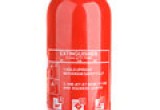Fire Protection Online Offers Wet Chemical Extinguisher Line
Online, June 25, 2010 (Newswire.com) - June 25, 2010-Fire Protection Online, an internet retailer of fire safety equipment, announces the addition of a wet chemical fire extinguisher line. Wet chemical extinguishers are the number one choice of fire safety experts when it comes to fighting grease and oil fires in homes and commercial kitchens.
In the United States alone, kitchen oil fires are the cause of many injuries and millions of dollars in damages each year. Two weeks ago in Wichita Falls, Texas the Casa Mañana restaurant was forced to close its doors temporarily after grease from a chip fryer started a blaze. The fryer was kept in the restaurant's 30 by 30-foot dish-washing section. In that area flames destroyed the entire room, including the roof and attic.
A few days earlier, in Elkmont, Alabama, a grease fire destroyed the Country Boy Cafe on Highway 127. The restaurant had only been in operation for a few months. The devastating fire started just before the restaurant's dinnertime rush began. On the rear patio, a fish fryer ignited. The heat from the flames was so intense that a nearby propane tank exploded, causing the rest of the building to be swallowed by flames.
Extinguishers of the wet chemical variety are designed to quickly put out kitchen blazes like these, as compared with powder fire extinguisher. They snuff out fires by forming a soapy, foam layer above the burning oil, fat or grease. Once covered the foam cools the oil so that the temperature drops below its ignition threshold. They are typically only used for class A and K fires (in the United States) or class F fires (in Europe). However, some of more current models are manufactured with misting nozzles for even more firefighting ability.
The active chemicals in these extinguishers include citrate, potassium acetate, or carbonate. Used widely in commercial kitchens and restaurant facilities, it is important that staff are instructed in the proper use of the extinguishers. In many facilities, building and safety codes require extinguishers be on hand and in working order. Restaurant owners should check with their local code enforcement or fire safety agency for information on fire equipment safety requirements.
Using these extinguishers is different than using other varieties. They don't spray quite as much, and the foam flows through a long lance applicator onto the fire, dousing the cooking fat. Then a chemical reaction occurs as the two substances combine, preventing the oil or grease from reigniting. If the entire area is not covered, there is a chance the fire could reignite. Oil fires can be very intense. Burning at more than 800 degrees, they can instantly cause third-degree burns.





